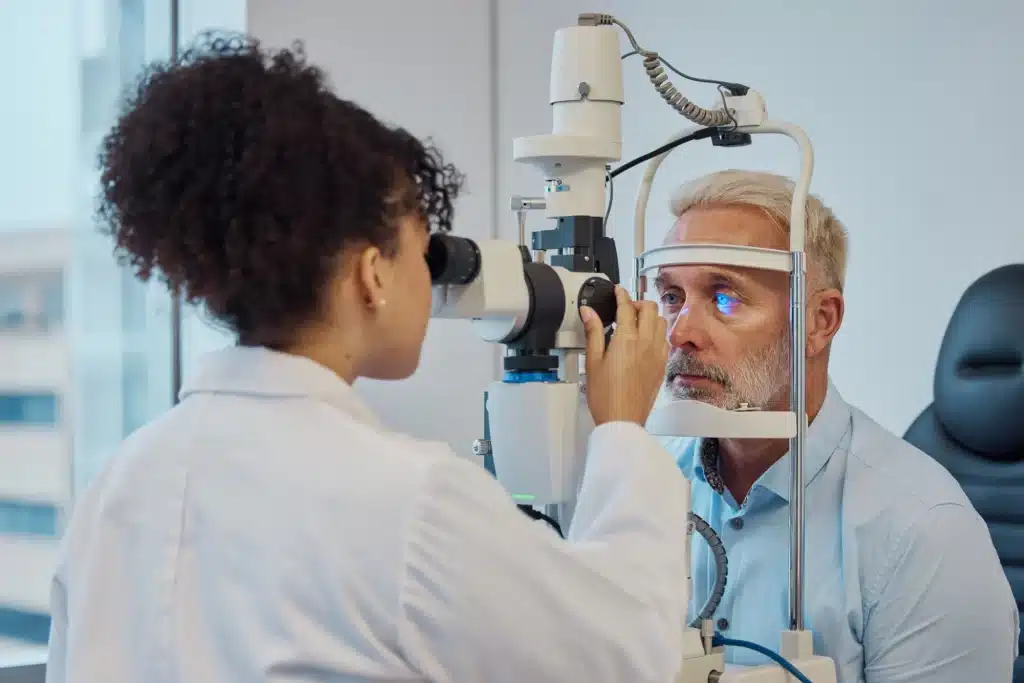Medically Reviewed by: Paul J. Stewart M.D.
Wet vs. Dry Macular Degeneration
The main difference between wet vs dry macular degeneration is simple: dry macular degeneration is the more common type of eye disease and does less damage to your vision while wet macular degeneration can result in serious vision loss.
Clinically, however, there are more specific differences between wet vs. dry macular degeneration that are slightly more involved. We’ll discuss these here along with other important information about the difference between wet and dry AMD.
For more resources regarding macular degeneration, check out our articles: What is Macular Degeneration?, Common signs of macular degeneration, and 5 Macular Degeneration Prevention Tips.
What causes macular degeneration?
Before we get into the details of wet vs. dry macular degeneration, it’s important to understand what macular degeneration is, in general. Macular degeneration is a chronic eye disease that gradually destroys central vision. When the process of transporting nutrients and waste by a layer of cells called the retinal pigment epithelium (RPE) is slowed down, yellowish deposits called drusen will form underneath the retina.
An excess of drusen is a telling sign that a person may have macular degeneration. Drusen cut off oxygen to your eye and may contribute to a thinning of the macula, the part of your retina that is responsible for giving you a clear line of sight. It’s this thinning of the macula that causes the damaged or lost vision characteristic of macular degeneration.
While macular generation is associated with aging, the cause of its onset is still unknown. Research indicates other additional hereditary and environmental factors risk factors including:
- Family history
- Cardiovascular disease and high blood pressure may place additional stress on the blood vessels, accelerating the development of vision loss
- Smoking will triple the risk of developing macular degeneration
- Elevated serum lipids (cholesterol and triglycerides) have been associated with an increased risk of macular degeneration
- Complement factor H is a marker of inflammation, and abnormalities in this gene have been linked to macular degeneration
- Excessive exposure to sunlight is a risk factor for eye disease, be sure to wear sunglasses or hats to protect your eyes from harmful rays
- And more
Research has shown that proper diet, exercise, and maintaining your overall health can lower your risk of developing macular degeneration. However, age still plays a role, as the odds of developing this disease are even greater once you reach 75 years of age.
What is dry macular degeneration?
Macular degeneration can often develop in two forms: dry (atrophic) or wet (exudative). The difference between wet vs dry macular degeneration is in the severity. Dry macular degeneration is the most common type of macular degeneration and is not as serious. About 85-90% of patients who develop macular degeneration develop the dry form. Most will experience minimal vision loss and excess development of large, soft drusen in the retina. The dry form can worsen over time if not seen by a specialist, and can result in the loss of central vision.
Can dry macular degeneration be treated?
There are currently no treatments that cure dry macular degeneration. However, clinical trials are currently being done for potential treatments. Dry macular degeneration treatment breakthroughs include stem cell therapies, an injection of the drug Apl-2, an oral antibiotic called Oracea, and an anti-inflammatory drug called Metformin. Most of these potential treatments are in phases two or three of their research and may not be available until for several more years.
What is wet macular degeneration?
Wet macular degeneration is the less common yet more serious type to develop. In the wet stage of macular degeneration, new blood vessels begin to form underneath the retina (choroidal neovascularization). Unfortunately, these new blood vessels often lead to blood or fluid leakage in the retina where vision can become distorted. In this stage, consulting a doctor is crucial. A good tool for identifying any changes in your vision is the macular degeneration amsler grid, a self-administered test in which straight lines will appear distorted if there is fluid underneath your retina.
Can wet macular degeneration be treated?
Similar to the dry form, treatment for wet macular degeneration has not been established yet. The best way to treat wet macular degeneration is to prevent the disease before it happens. This can be done with injections, laser procedures, and maintaining a healthy lifestyle. If caught late, these treatment options will help manage the side effects of wet macular degeneration.
Additional wet vs. dry macular degeneration FAQs
Which is worse, dry or wet macular degeneration?
Wet macular degeneration is more serious and is the leading cause of permanent central vision loss. Though the dry type is less serious, it can lead to the wet type if not monitored closely by a doctor.
How often does dry macular degeneration turn into wet?
About 1-in-10 people who suffer from dry macular degeneration will eventually develop wet macular degeneration. Though not as common, it’s still possible, so be sure to visit your eye doctor regularly if you already have dry macular degeneration.
How can I avoid macular degeneration?
Even if you aren’t experiencing any symptoms of macular degeneration, early prevention is your best chance at stopping or slowing down the disease. Luckily, the prevention tips are easy to follow — see your eye doctor regularly, prioritize diet and exercise, don’t smoke, take vitamins, or consider other types of prevention therapy as recommended by your doctor.
Spot the signs early, save your eyesight: Contact Eye Center of Texas today.
If you are over the age of 50 and notice some of the signs and symptoms of macular degeneration like worsening eyesight, blurred vision, etc. we recommend you visit our retina specialist here at Eye Center of Texas.
We are here to help answer any questions you may have regarding wet vs. dry macular degeneration, eye health tips, and more.
Spotting macular degeneration early can help to avoid vision loss in the future. Give us a call at 713-797-1010 or request an appointment online today.
More Helpful Articles by Eye Center of Texas:
Related Articles
Financing Options Available
Apply today to find a financing option that meets your needs.
Our Locations
Houston/Bellaire
6565 W. Loop S., Suite 650Bellaire, TX 77401
Medical Office:
713-797-1010
Medical Fax:
713-357-7276
LASIK/Near Vision:
Office: 713-395-1515
Fax: 713-357-7278
Pasadena
4415 Crenshaw RoadPasadena, TX 77504
Medical Office:
281-977-8800
Medical Fax:
281-977-8877
Sugar Land
15200 S.W. Freeway, Suite 130Sugar Land, TX 77478
Medical Office:
281-277-1010
Medical Fax:
281-277-4504
Clear Lake
455 E. Medical Center Blvd., Suite 110Webster, TX 77598
Medical Office:
281-332-1397
Medical Fax:
281-282-9152
Katy
Greenhouse Medical Plaza2051 Greenhouse Road, Suite 110
Houston, TX 77084
Medical Office:
346-547-7070
Medical Fax:
281-214-2971
The Woodlands/Conroe
100 Medical Center Blvd., Suite 118Conroe, TX 77304
Medical Office:
936-647-1610
Medical Fax:
936-647-1620


